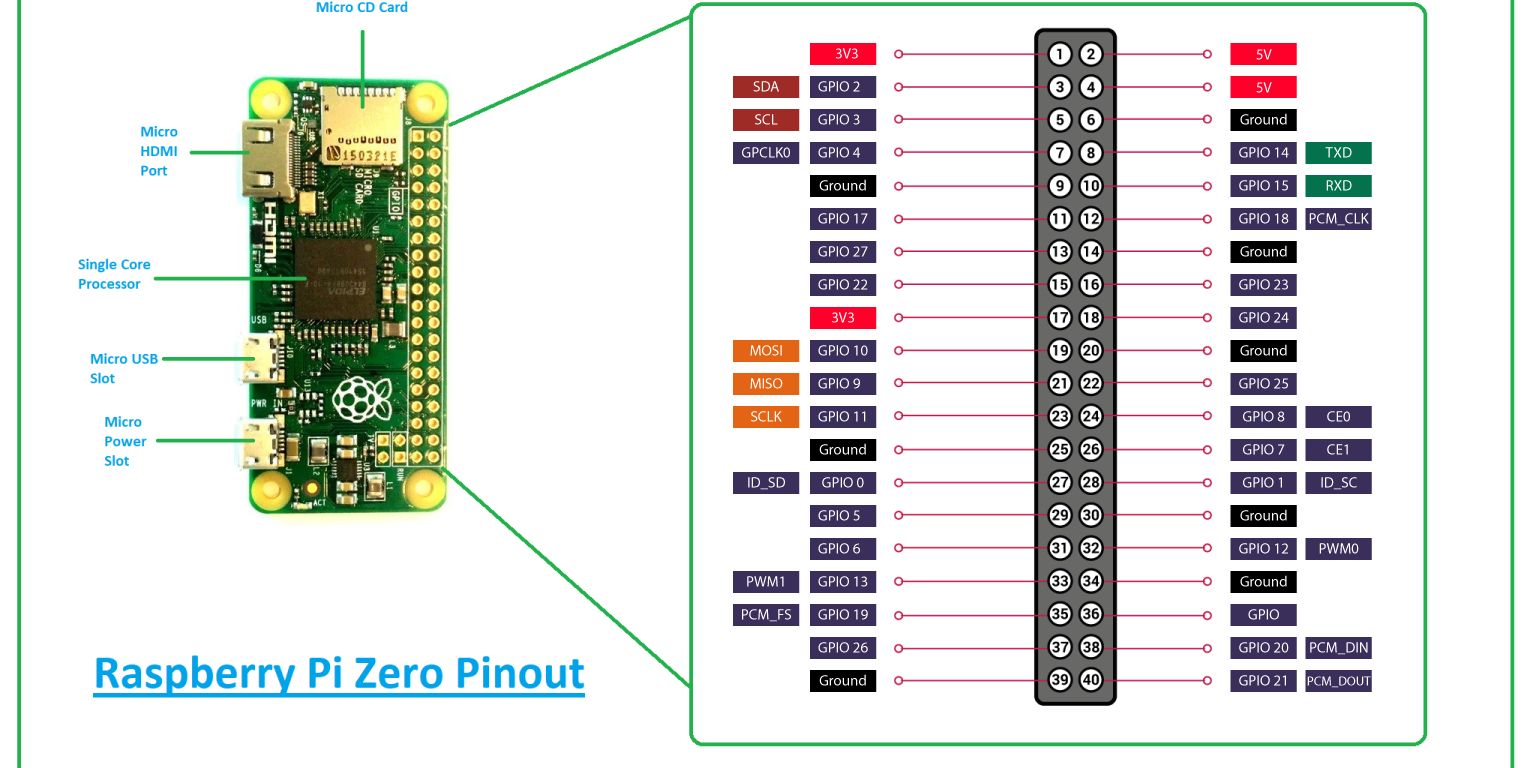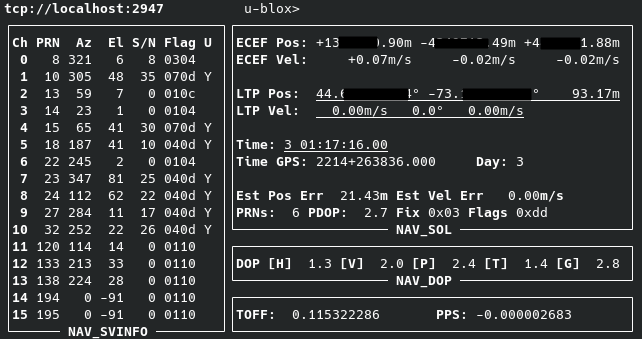Project 1: GPS-based NTP server
Source: Microsecond accurate NTP with a Raspberry Pi and PPS GPS
Info
This page describes setting up a GPS module with a Pi to act as a Stratum1 NTP server. The GPS module must have a 3-5V input, with serial AND PPS outputs (5 pins minimum). Example: Adafruit Ultimate GPS Breakout.
PPS = Pulse Per Second. While the serial data from the GPS module contains the actual time & date information required for the NTP server, the PPS input is required to keep sub-millisecond accuracy. the PPS output puts out EXACTLY 1 pulse per second, +/- a few nanoseconds. The PPS software running on the Pi uses this
Setup:
-
Install packages:
sudo apt install pps-tools gpsd gpsd-clients gpsd-tools chrony('pps/gpsd' packages are for interperating GPS data, chrony is an NTP server)
-
Add these lines to the end of
/boot/config.txt# the next 3 lines are for GPS PPS signals dtoverlay=pps-gpio,gpiopin=18 enable_uart=1 init_uart_baud=9600 -
Add this text to the end of
/etc/modules:pps-gpio
These programs and config changes enable PPS time sync inputs on GPIO pin 18 (real Pin 12), and initializes the serial COM port with a baud rate of 9600.
- disable system handling the COM port:
sudo systemctl mask serial-getty@ttyS0.service
This prevents the system from taking control of the port. Check this command worked after rebooting: /dev/ttyS0 should be owned by root:dialout and have permissions crw-rw----.
Wire up the GPS module:
Pinout:
- GPS PPS to RPi pin 12 (GPIO 18)
- GPS VIN to RPi pin 2 or 4
- GPS GND to RPi pin 6
- GPS RX to RPi pin 8
- GPS TX to RPi pin 10
Picture reference (note that all the Pi pins are seqential):

Check GPS functionality
The GPS device should put out either 3.3V or 5V on the antenna connector to power the antenna. With the GPS module powered, The on-board LED will light solid. The LED will start blinking once it has a GPS lock. The module spits data to the serial lines at all times, there is no bi-directional communication!
-
Check that the pps serice is running:
lsmod | grep ppsShould return at least the service
pps_core. -
Check for PPS pulses (after GPS has a lock):
sudo ppstest /dev/pps0 ### Output: trying PPS source "/dev/pps0" found PPS source "/dev/pps0" ok, found 1 source(s), now start fetching data... source 0 - assert 1655253832.999996389, sequence: 966 - clear 0.000000000, sequence: 0 source 0 - assert 1655253834.000004254, sequence: 967 - clear 0.000000000, sequence: 0 source 0 - assert 1655253835.000001120, sequence: 968 - clear 0.000000000, sequence: 0 source 0 - assert 1655253836.000000985, sequence: 969 - clear 0.000000000, sequence: 0 source 0 - assert 1655253836.999996852, sequence: 970 - clear 0.000000000, sequence: 0 source 0 - assert 1655253838.000001719, sequence: 971 - clear 0.000000000, sequence: 0 source 0 - assert 1655253839.000002586, sequence: 972 - clear 0.000000000, sequence: 0 source 0 - assert 1655253840.000001453, sequence: 973 - clear 0.000000000, sequence: 0 ### ...etc
If there is a timout, then there is likely not a good GPS lock yet.
Set up software:
- Edit
/etc/default/gpsd:- change
GPSD_OPTIONS=””toGPSD_OPTIONS=”-n” - change
START_DAEMON="false"toSTART_DAEMON="true" - change
DEVICES=””toDEVICES=”/dev/ttyS0 /dev/pps0″
- change
- edit
/etc/chrony/chrony.conffile, add this block of code to the top:### GPS TIME SYNC INFO # delay determined experimentally by setting noselect then monitoring for a few hours # offset 0.120 means the NMEA serial source lags PPS by 120ms # adjust offset if NMEA source is off by more than 10ms in chrony refclock SHM 0 offset 0.120 refid NMEA refclock PPS /dev/pps0 refid PPS # allow LAN devices to access chrony as an ntp server: allow 192.168.1.0/24 allow 192.168.2.0/24 ### END GPS TIME SYNC INFO - Reboot the Pi.
- Check: after rebooting, run the program
gpsmon, it should display a window similar to this:
This confirms that the software is decoding the GPS info properly.
- Check Chrony is selecting GPS as a time source; run
chronyc sources
More info here under the header 'Time Sources'. TLDR: 'PPS' should have a '*' next to it, and the [bracketed] time in the 'NMEA' row should be less than ~5msec. change the offset in the### Output: MS Name/IP address Stratum Poll Reach LastRx Last sample =============================================================================== #- NMEA 0 4 377 15 +3794us[+3794us] +/- 470us #* PPS 0 4 377 16 +351ns[ +515ns] +/- 3000ns ^- time.cloudflare.com 3 6 377 70 -2009us[-2008us] +/- 16ms ^- smtp.us.naz.com 2 6 377 2 -26ms[ -26ms] +/- 105ms ^- hc-007-ntp1.weber.edu 2 6 377 5 +3131us[+3131us] +/- 72ms ^- dns2.kcweb.net 2 6 377 6 +1296us[+1296us] +/- 88mschrony.conffile to adjust this value, and restart chrony with the commandsudo systemctl restart chrony.
Set up other machines to use the Pi as an NTP server (Linux):
- Install
ntppackage on the machine - Edit
/etc/ntp.confand addserver [pi.local.ip] trueto the list of servers - start the ntp service (on Arch:
sudo systemctl start ntpd) - Check the NTP sources with
ntpq -p:
Check back in about 20 minutes, after which one source should have a '*' next to it to indicate that server is the chosen server. Remove default NTP servers and restart the ntp service if the pi is not selected. Note:remote refid st t when poll reach delay offset jitter ============================================================================== 192.168.1.137 .PPS. 1 u 35 64 1 1.851 +144501 0.001 time.walb.tech 50.205.244.21 3 u 34 64 1 82.802 +144501 0.001 li1187-193.memb 132.163.96.3 2 u 30 64 1 179.522 +144501 0.001 time-dfw.0xt.ca 68.166.61.255 2 u 33 64 1 106.817 +144501 0.001 LAX.CALTICK.NET 17.253.26.253 2 u 32 64 1 118.527 +144501 0.001trueadded after the pi's IP in the config indicates it is more "trustworthy" than other sources, and is more likely to be picked.
Set up other machines to use the Pi as an NTP server (Windows):
- Install Dimension 4.
- add the pi as an SNTP source, set the sync time to every 5 minutes.
- In the advanced settings menu, force the program to only sync the selected server to force it to use the pi.